Introduction
Materials and Methods
Analysis of the skulls
Prevalence, number and position of AIOF
Determination of IOF and AIOF location under stereoscopic microscope
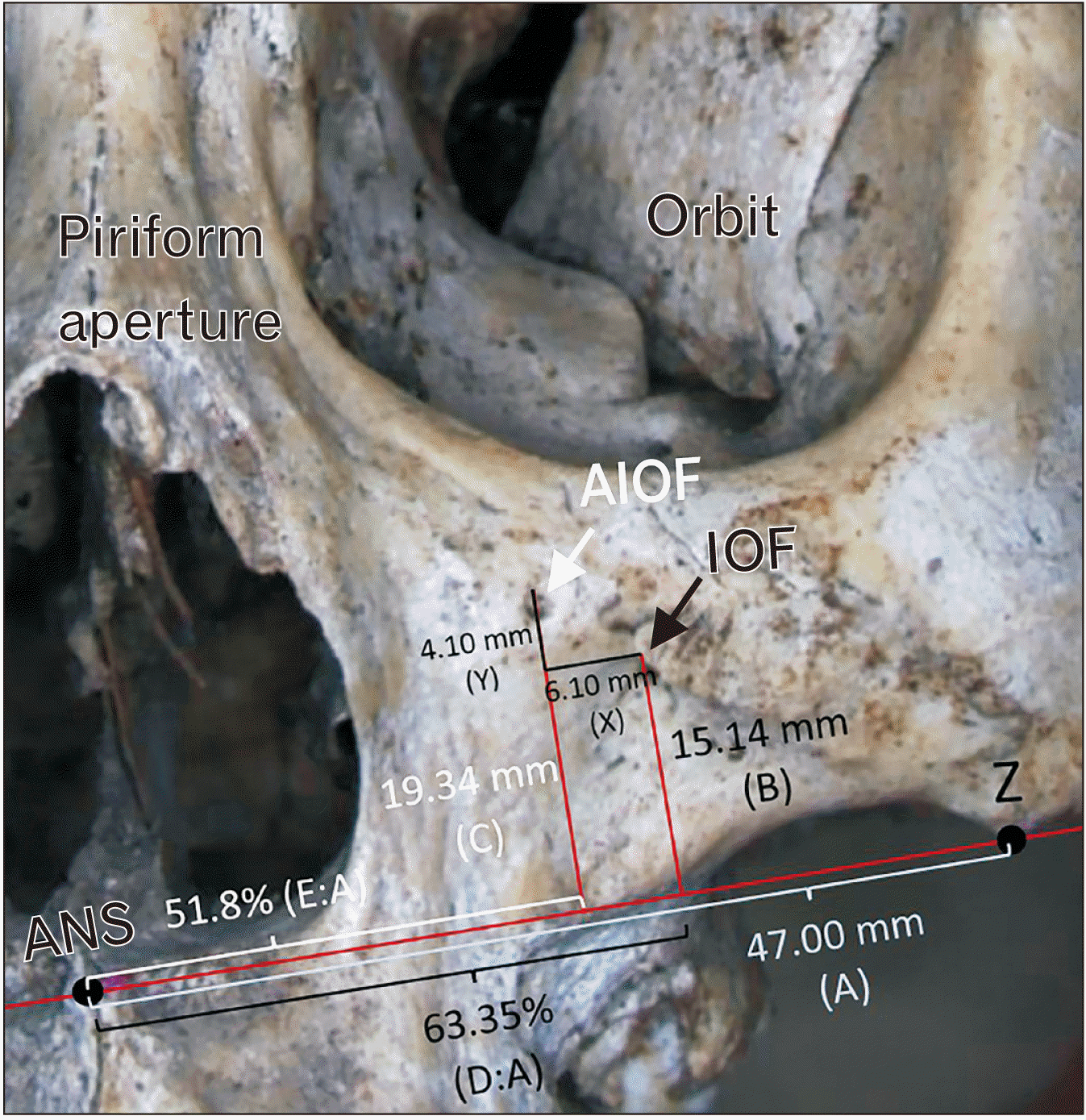 | Fig. 1Picture of skull illustrates the value of main parameters of IOF and AIOF with reference to the horizontal line from ANS to Z (unit: millimeters). A, distance from ANS to Z; AIOF, accessory infraorbital foramen; ANS, anterior nasal spine; B, vertical distance from the middle-upper edge of IOF to the line A; C, vertical distance from the middle-upper edge of AIOF to line A; D, horizontal distance from ANS to the intersecting point of the vertical line from IOF with line A; D:A, percentage of the ratio of distance D to distance A; E, horizontal distance from ANS to the intersecting point of the vertical line from AIOF with line A; E:A, percentage of the ratio of distance E to distance A; IOF, infraorbital foramen; X, horizontal distance between IOF and AIOF; Y, vertical distance between IOF and AIOF; Z, the lowest point of zygomaticomaxillary junction. |
Accuracy assessment in cadaveric dissection
Statistical analysis
Results
Prevalence, number, and location of AIOF
Predictive method for localization of IOF and AIOF
Table 1
| Parameter (mm) | Side | Sex | Total | |||||
|---|---|---|---|---|---|---|---|---|
| Left | Right | P-value | Male | Female | P-value | |||
| A | 47.04±2.96 | 46.97±2.94 | 0.711 | 47.46±2.90 | 45.90±2.78 | <0.001* | 47.00±2.95 | |
| B | 15.12±2.03 | 15.16±1.95 | 0.711 | 15.18±1.94 | 15.05±2.11 | 0.533 | 15.14±1.99 | |
| C | 19.42±3.20 | 19.25±3.57 | 0.200 | 19.50±3.13 | 18.98±3.87 | 0.510 | 19.34±3.36 | |
| D | 29.81±2.35 | 29.69±2.29 | 0.481 | 30.06±2.25 | 29.00±2.32 | <0.001* | 29.75±2.32 | |
| E | 24.62±2.66 | 24.16±3.59 | 0.483 | 24.60±3.26 | 23.95±2.73 | 0.374 | 24.41±3.11 | |
| X | 5.91±2.04 | 6.32±2.38 | 0.837 | 6.22±2.38 | 5.83±1.72 | 0.453 | 6.10±2.20 | |
| Y | 4.00±2.13 | 4.22±2.01 | 0.214 | 4.08±2.24 | 4.16±1.62 | 0.845 | 4.10±2.06 | |
| D:A (%) | 63.42±4.02 | 63.26±3.79 | 0.725 | 63.40±4.00 | 63.21±3.66 | 0.662 | 63.35±3.90 | |
| E:A (%) | 52.40±5.27 | 51.11±6.56 | 0.753 | 51.54±6.35 | 52.41±4.77 | 0.534 | 51.80±5.90 | |
Values are presented as mean±SD. A, distance from anterior nasal spine (ANS) to the lowest point of the zygomaticomaxillary junction; B, vertical distance from the middle-upper edge of infraorbital foramen (IOF) to line A; C, vertical distance from the middle-upper edge of accessory infraorbital foramen (AIOF) to line A; D, horizontal distance from ANS to the intersecting point of the vertical line from IOF with line A; E, horizontal distance from ANS to the intersecting point of the vertical line from AIOF with line A; X, horizontal distance between IOF and AIOF; Y, vertical distance between IOF and AIOF; D:A, percentage of the ratio of distance D to distance A; E:A, percentage of the ratio of distance E to distance A. *Statistically significant difference between groups.
Accuracy assessment of the predictive method in cadavers
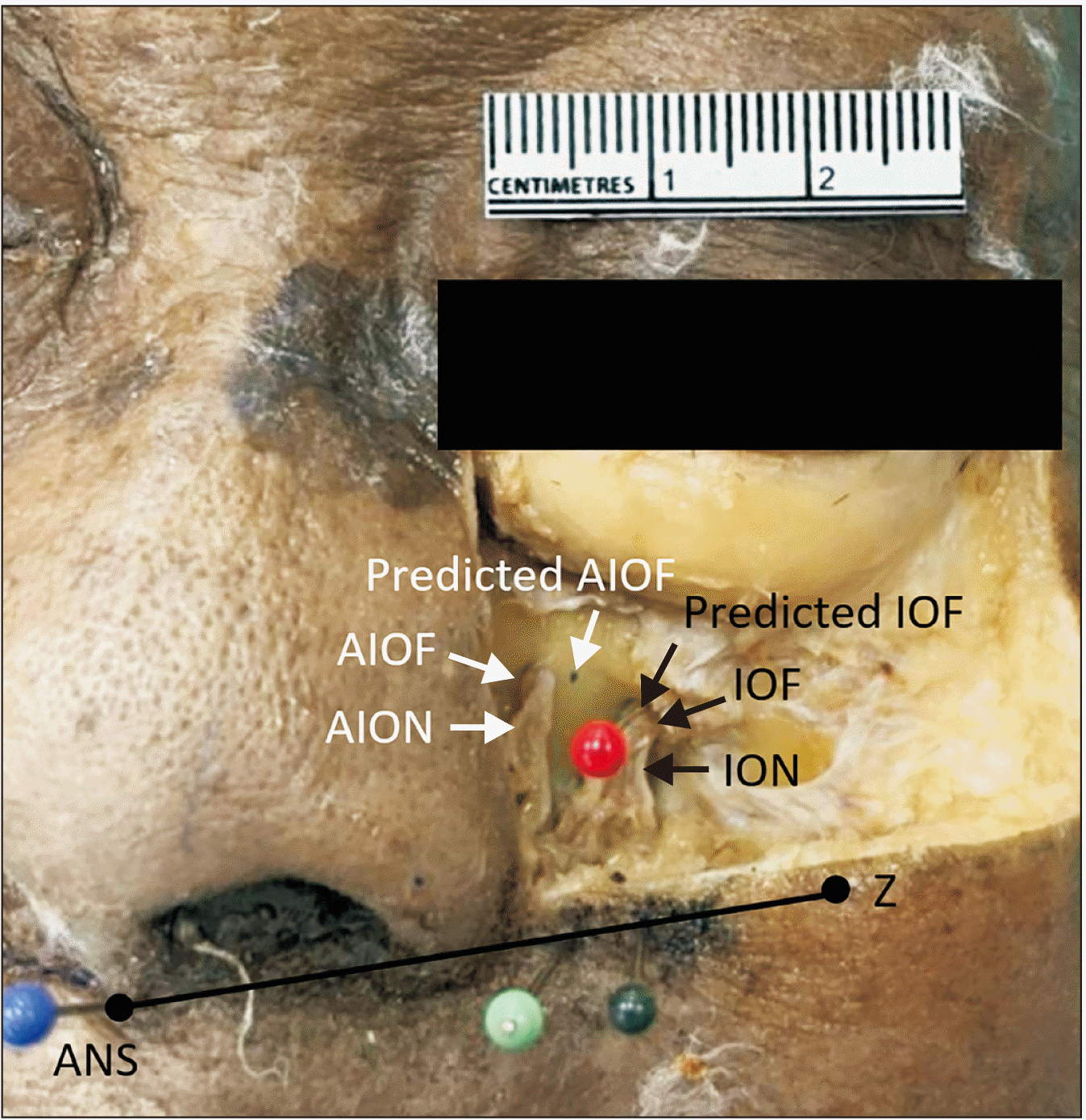 | Fig. 3Picture of left midface of a male cadaver showing the same location of both predicted IOF and the exact IOF (tip of red pin). The predicted AIOF was lateral to the exact AIOF. Dark green pin, location of the predicted distance D (distance A multiplied with the percentage of D:A); light green pin, location of the predicted distance E (distance A multiplied with the percentage of E:A); red pin, location of the predicted IOF; blue dot, the location of the predicted AIOF; blue pin, location of the anterior nasal spine. AIOF, accessory infraorbital foramen; AION, accessory infraorbital nerve; ANS, anterior nasal spine; IOF, infraorbital foramen; ION, infraorbital nerve; Z, the lowest point of zygomaticomaxillary junction; black line, the line between ANS and the lowest point of zygomaticomaxillary junction. |
Table 2
| Parameter (mm) | Side | Sex | Total | |||||
|---|---|---|---|---|---|---|---|---|
| Left | Right | P-value | Male | Female | P-value | |||
| A | 47.29±2.32 | 46.86±2.25 | 0.117 | 47.22±2.86 | 46.91±1.36 | 0.705 | 47.07±2.26 | |
| Predicted D | 29.96±1.47 | 29.69±1.42 | 0.117 | 29.91±1.81 | 29.72±0.86 | 0.706 | 29.82±1.43 | |
| Predicted E | 24.49±1.20 | 24.27±1.17 | 0.117 | 24.46±1.48 | 24.30±0.70 | 0.704 | 24.38±1.17 | |
| F | 0.64±1.16 | 1.56±1.57 | 0.019* | 1.11±1.38 | 1.09±1.55 | 0.979 | 1.10±1.44 | |
| G | 0.40±1.05 | 0.79±1.67 | 0.138 | 0.41±1.13 | 0.80±1.65 | 0.453 | 0.59±1.39 | |
| H | 1.83±0.15 | - | - | - | - | - | 1.83±0.15 | |
| I | 0 | - | - | - | - | - | 0 | |
Values are presented as mean±SD. A, distance from anterior nasal spine (ANS) to the lowest point of the zygomaticomaxillary junction; Predicted D, distance A multiplied with the percentage of ratio D:A (63.35%); Predicted E, distance A multiplied with the percentage of ratio E:A (51.8%); F, the shortest horizontal distance from the predicted infraorbital foramen (IOF) to the exact IOF; G, the shortest vertical distance from the predicted IOF to the exact IOF; H, the shortest horizontal distance from the predicted accessory infraorbital foramen (AIOF) to the exact AIOF; I, the shortest vertical distance from the predicted AIOF to the exact AIOF. *Statistically significant difference between groups.
Discussion
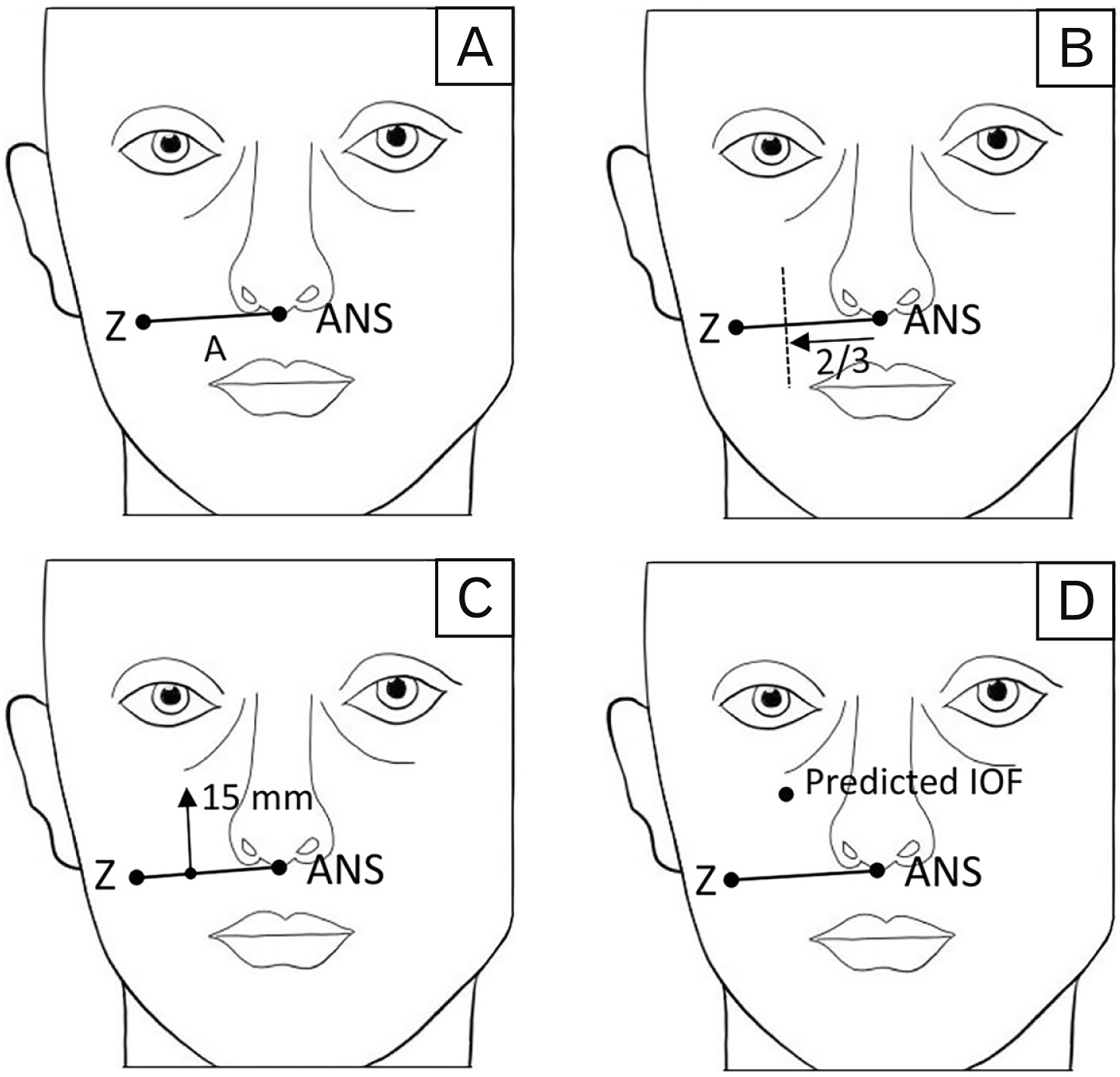 | Fig. 4Illustration describing the predictive method for localization of IOF in clinical practice. (A) Mark the location of ANS at the uppermost part of philtrum at the level of nostrils and Z at the lowest bony prominence of cheek. Draw line A between ANS and Z. (B) Mark at the medial two-thirds of line A (black dot line). (C) Draw perpendicularly with and above line A at approximately 15 mm. (D) Mark the location of predicted IOF. A, distance from ANS to Z; ANS, anterior nasal spine; IOF, infraorbital foramen; Z, the lowest point of the zygomaticomaxillary junction. |
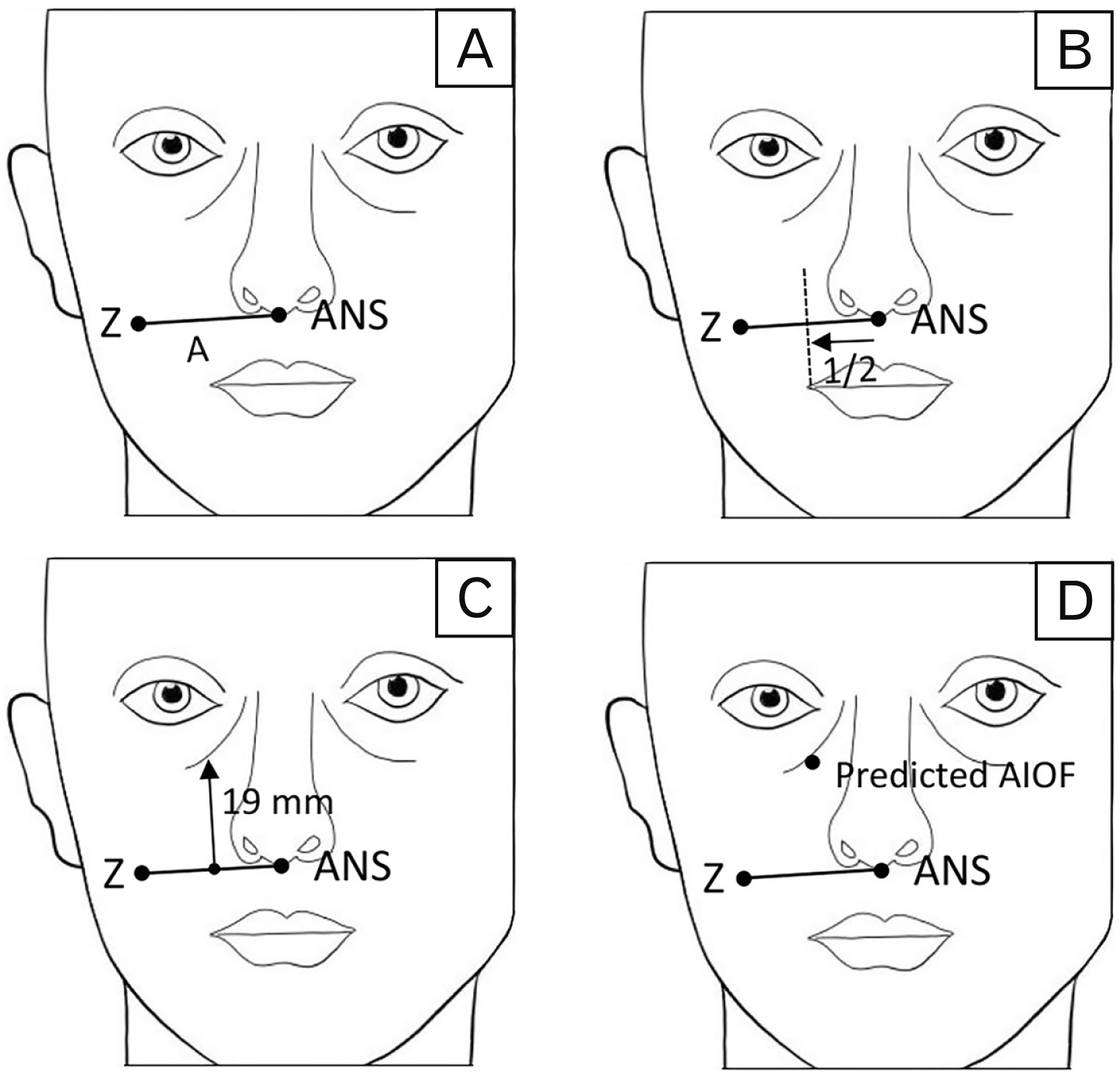 | Fig. 5Illustration describing the predictive method for localization of AIOF in clinical practice. (A) Mark the location of ANS at the uppermost part of philtrum at the level of nostrils and Z at the lowest bony prominence of cheek. Draw line A between ANS and Z. (B) Mark at the middle of line A (black dot line). (C) Draw perpendicularly with and above line A at approximately 19 mm. (D) Mark the location of predicted AIOF. A, distance from ANS to Z; AIOF, accessory infraorbital foramen; ANS, anterior nasal spine; Z, the lowest point of the zygomaticomaxillary junction. |




 PDF
PDF Citation
Citation Print
Print



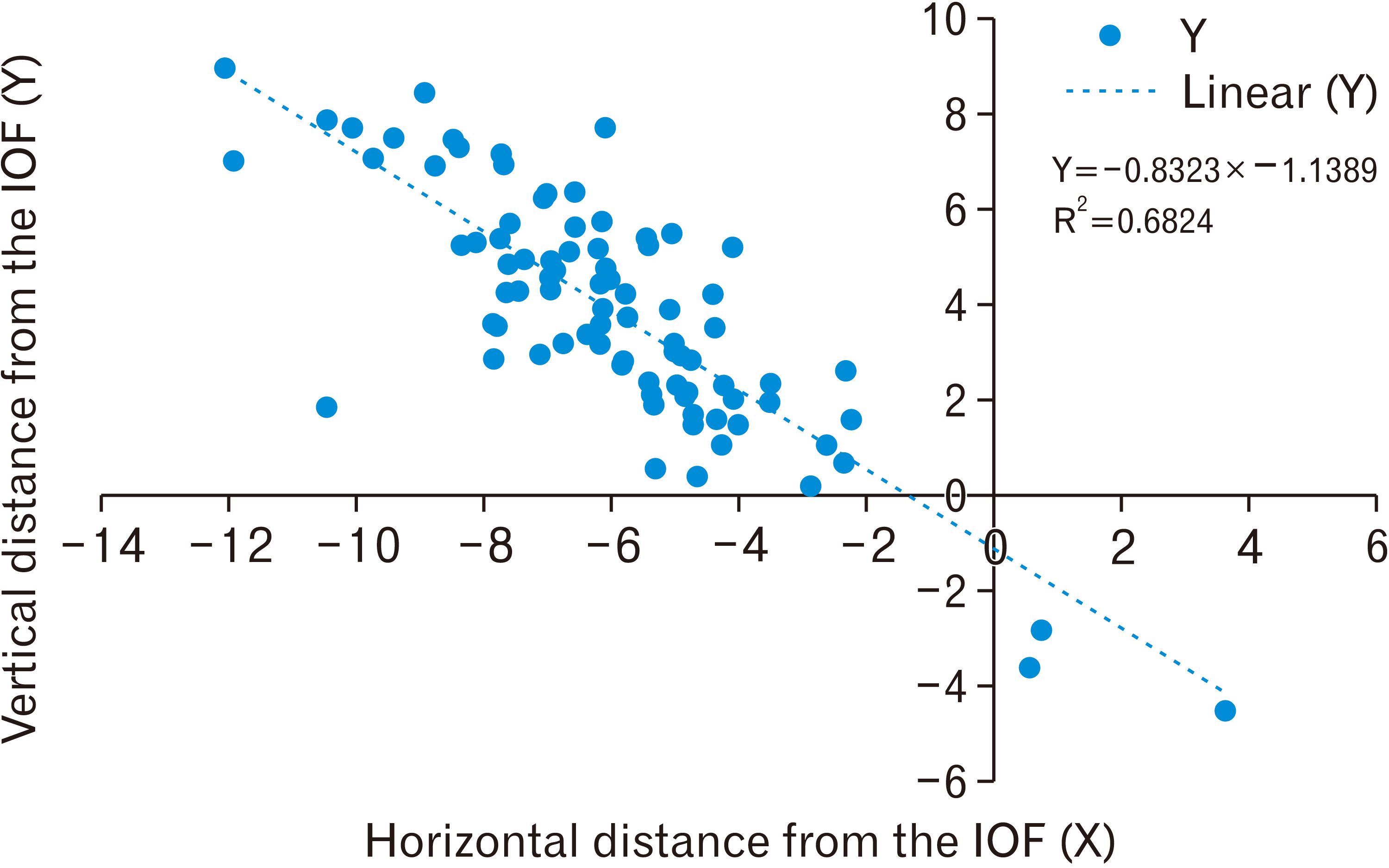
 XML Download
XML Download